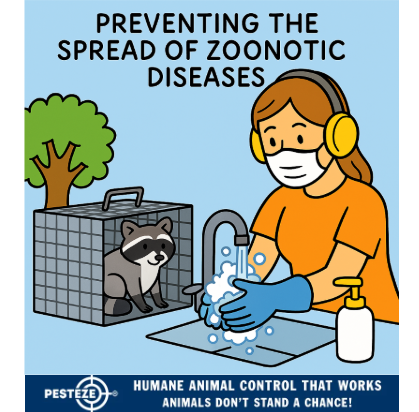PREVENTING THE SPREAD OF ZOONOTIC DISEASES

PREVENTING THE SPREAD OF ZOONOTIC DISEASES
SUMMARY
Zoonotic diseases—those transmitted between animals and humans—pose serious public health risks worldwide. From rabies to avian flu, these illnesses can spread through direct contact, contaminated environments, or vectors like ticks and mosquitoes. This guide offers practical, science-backed strategies to reduce transmission risks in homes, farms, and wildlife settings. Whether you're a pet owner, farmer, or wildlife worker, understanding zoonotic prevention is essential for safeguarding both human and animal health.
FEATURES
-
Understanding Transmission: Explains how zoonotic diseases spread and the key risk factors.
-
Hygiene Protocols: Offers sanitation tips for homes, farms, and animal facilities.
-
Protective Equipment: Recommends gear for safe handling of animals and waste.
-
Vaccination Strategies: Highlights essential vaccines for pets, livestock, and humans.
-
Wildlife Interaction Guidelines: Advises on safe practices when encountering wild animals.
-
Reporting and Monitoring: Encourages early detection and communication with health authorities.
GUIDE DESCRIPTION
Zoonotic diseases are infections that jump between animals and humans, often with serious consequences. Preventing their spread requires a multi-layered approach that combines hygiene, education, and proactive health measures. This guide is designed to help individuals and organizations reduce the risk of zoonotic transmission in everyday settings.
Start by identifying common zoonotic threats in your region—these may include rabies, leptospirosis, salmonella, or avian influenza. Understanding how these diseases spread is critical. Transmission can occur through bites, scratches, bodily fluids, contaminated surfaces, or insect vectors.
Implement strict hygiene protocols. Wash hands thoroughly after handling animals, clean cages and enclosures regularly, and disinfect tools and surfaces. In farm settings, isolate sick animals and maintain clean feeding and watering stations. Use personal protective equipment (PPE) like gloves, masks, and boots when dealing with animals or waste.
Vaccination is a powerful tool. Ensure pets and livestock are up to date on recommended vaccines, and consult healthcare providers about human vaccines for high-risk individuals. Avoid direct contact with wild animals, and never attempt to feed or relocate them without professional guidance.
Monitoring and reporting are vital. Keep records of animal health, and report unusual symptoms or deaths to veterinary or public health authorities. Early detection can prevent outbreaks and protect entire communities.
By following these guidelines, you contribute to a healthier environment for both humans and animals. Zoonotic disease prevention isn’t just a medical concern—it’s a shared responsibility rooted in awareness, action, and compassion.
- Amy Chang


Comments 0